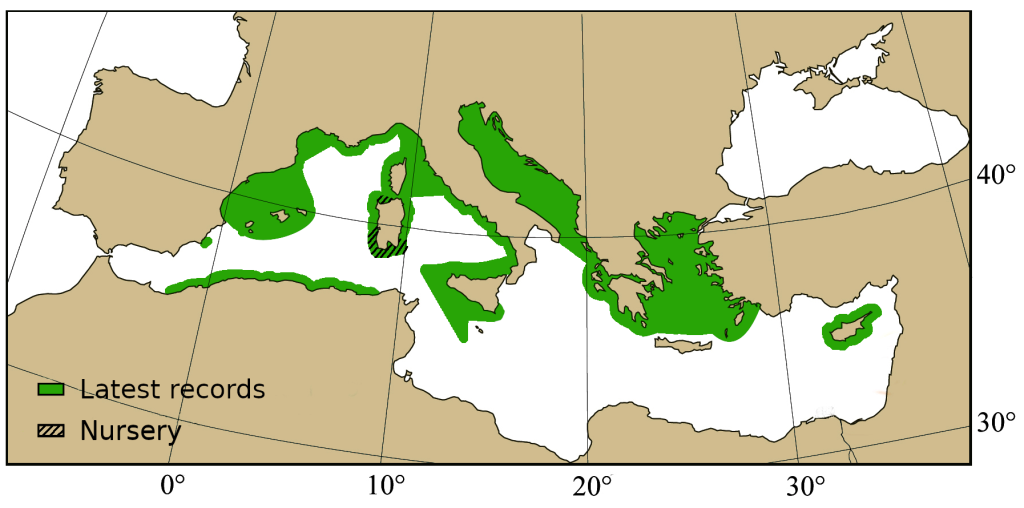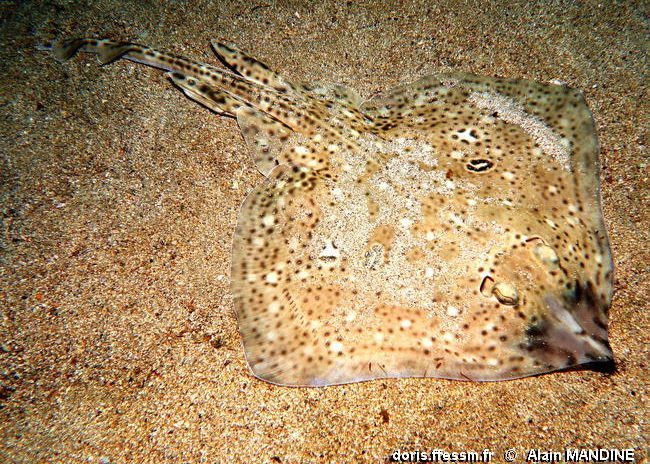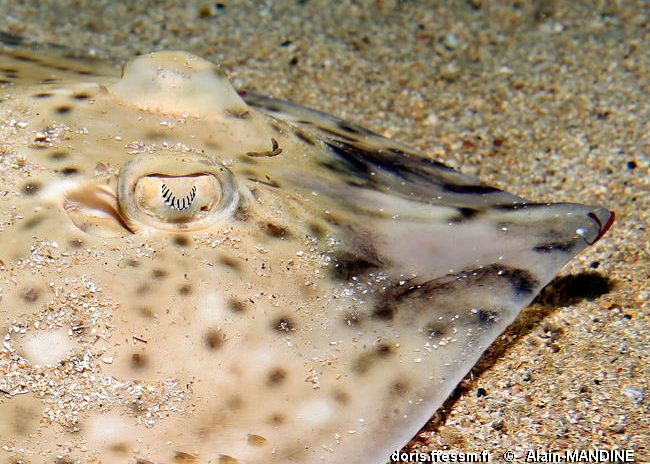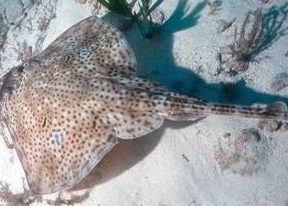Raja polystigma
Common name: Speckled Skate
Order: Rajiformes
Family: Rajidae
Synonyms: None
Misidentifications: Raja montagui, Raja brachyura
Short description
Medium-sized species. Angular disc with a circular body with pectoral fins wider than long and an edge forming a sinuous curve. Pectoral fins with clear angles on the lateral side. Triangular pelvic fins. Short snout with rounded, thorny tip. Smooth dorsal surface with spines on higher margins. Smooth ventral surface but not on the muzzle.
Color: Brown dorsal surface with an irregular pattern consisting of black dots and light spots, presence of a narrow white band surrounding the disc. Scattered black spots may not reach the extremity of the pectoral fins. Frequent presence of large black spots in the middle of the pectoral fin.
Measurements:
- Total length (TL): 50-60cm (max 71 cm)
Swimming pattern: Undulatory and pelvic fin locomotion (walking and punting).
Egg case
Rectangular with stiff pointed horns at the corners. Deposited in sandy or muddy flats. Rounded and narrow posterior apron and a moderately developed straight anterior one. Moderate and sturdy posterior horns. Moderate and thin anterior horns. Straight and moderate anterior apron. Rounded and narrow posterior apron. Narrow keels with adhesion fibres.
Fresh color: Brown with yellow at the edges
Size: 35-46 mm length.
Distinctive features:
- Egg-case length < 5 cm

Raja: Long posterior horns. Anterior horns length less than twice the posterior.
Rajiformes / Rajidae: Rectangular egg-case, width no greater than twice the capsule length.
Biology / Ecology
Feeds mainly on crustaceans and bony fishes.
Reproduction: Oviparous. Size at maturity (TL): 53 cm males, 63 cm females. Egg laid in summer, on the continental shelf. Eggs per year: ~20-62.
Habitat: Demersal species, mainly found on deep soft bottoms of the continental shelf. Benthic from shallow waters to 650 m but more common on sandy and muddy bottoms from 100 m to 400 m of depth. Possibly occurs down to 800 m deep.
Mainly misidentified with R. montagui. Observations now often recorded as R. cf. polystigma.
Distinguishing characteristics
- Frequently large dark spots on each middle pectoral fin.
- Regular row of 22–28 thorns on tail, a thorn between dorsal fin.
Rajiformes / Rajidae: Depressed body. Circular to rhombic disc. Tail well demarcated from disc.
Distribution
Worldwide: Endemic species from Mediterranean Sea. Absent from Black Sea.
Mediterranean: Near panmictic population in the central-western Mediterranean (except for the Adriatic population which present a slightly differentiated haplotype).
- Occurrence: Common in the western and western-central Mediterranean Sea.
- Latest records: Cyprus (2018-2022), Adriatic Sea (2012-2015), Balearic Islands (2012-2015), Gulf of Lion – France (2012-2015), Italy (2012-2015), Greece (2012-2015), Aegean Sea (2012-2015), Catalan Sea (2013), Algeria (2003-2004), Calabria – Italy (2001).

Any recent observation not on the map?
Contact us!
Conservation
Threats: Taken as bycatch in demersal trawl fisheries. Also fished with gillnets longlines and hand lines in artisanal fisheries.
Protection level:
- Global, Europe & Mediterranean: Least Concern (IUCN 2015, last assessment: 2014)
Key references
- Baino R., Serena F., Ragonese S., Rey J. and Rinelli P. 2001. Catch composition and abundance of Elasmobranchs based on the MEDITS program. Rapports de la Commission Internationale pour L’Exploration Scientifique de la Mer Méditerranée 36: 234.
- Cannas R., Pasolini P., Mancusi C., Follesa M.C., Cabiddu S., Hemida F., Serena F., Tinti F. 2008. Distribution, molecular systematics and phylogeography of Raja polystigma and Raja montagui in the Mediterranean. Biologia Marina Mediterránea 15(1): 188-191.
- Carpentieri P., Nastasi A., Sessa M., Srour A. 2021. Incidental catch of vulnerable species in Mediterranean and Black Sea fisheries – A review. General Fisheries Commission for the Mediterranean – Studies and Reviews 101: I-317.
- Ellis J.R., Dulvy N.K., Jennings S., Parker-Humphreys M., Rogers, S.I. 2005. Assessing the status of demersal elasmobranchs in UK waters: a review. Journal of the Marine Biological Association of the United Kingdom 85: 1025-1047.
- Ferretti F., Osio G.C., Jenkins C.J., Rosenberg A.A., Lotze H.K. 2013. Long-term change in a meso-predator community in response to prolonged and heterogeneous human impact. Scientific reports 3(1): 1-11.
- Giovos I., Serena F., Katsada D., Anastasiadis A., Barash A., Charilaou C., Hall-Spencer J.M.,Crocetta F.,Kaminas A., Kletou D, Maximiadi M., Minasidis V., Moutopoulos D.K., Aga-Spyridopoulou R.N., Thasitis I., Kleitou P. 2021. Integrating literature, biodiversity databases, and citizen-science to reconstruct the checklist of Chondrichthyans in Cyprus (Eastern Mediterranean Sea). Fishes 6(3): 24.
- Mancusi C., Massi D., Baino R., Cariani A., Crobe V., Ebert D.A., Ferrari, C, Gordon A., Hoff G.R., Iglesias S.P., Titone A., Serena F. 2021. An identification key for Chondrichthyes egg cases of the Mediterranean and Black Sea. The European Zoological Journal 88(1): 436-448.
- O’Keefe M., Bengil EG., Palmer JL, Beton D, Çağlar Ç., Godley B.J, Özkan M., Snape R.T.E., Broderick A.C. 2023. Diversity and distribution of elasmobranchs in the coastal waters of Cyprus: using bycatch data to inform management and conservation. Front. Mar. Sci. 10: 1181437.
- Ordines F., Massutí E., Moranta J., Quetglas A., Guijarro B., Fliti K. 2011. Balearic Islands vs Algeria: two nearby western Mediterranean elasmobranch assemblages with different oceanographic scenarios and fishing histories. Scientia Marina 75(4): 707-717.
- Porcu C., Marongiu M.F., Bellodi A., Cannas R., Cau A., Melis R., Mulas A., Soldovilla G., Vacca L., Follesa M.C. 2017. Morphological descriptions of the eggcases of skates (Rajidae) from the central-western Mediterranean, with notes on their distribution. Helgoland Marine Research 71(1): 1-14.
- Soldo A., Lipej L. 2022. An Annotated Checklist and the Conservation Status of Chondrichthyans in the Adriatic. Fishes 7(5): 245.



